
Journal of Early Modern Studies-Romania
Scope & Guideline
Advancing Multidisciplinary Insights into Romania's Early Modern Era
Introduction
Aims and Scopes
- Philosophical Inquiry:
The journal frequently engages with philosophical texts and concepts from the early modern period, such as the works of Spinoza, Locke, and Descartes, exploring their implications on contemporary thought. - Art and Visual Culture:
There is a significant focus on the analysis of visual arts from the early modern era, particularly works by influential artists like Caravaggio, which are examined in the context of their historical and cultural significance. - Interdisciplinary Approaches:
The journal adopts interdisciplinary methodologies, combining insights from philosophy, art history, science, and cultural studies to provide a comprehensive understanding of early modern studies. - Historical Contextualization:
Articles often contextualize philosophical ideas and artistic expressions within the broader socio-political and religious landscapes of the early modern period, highlighting the interplay between knowledge and power. - Emerging Themes in Enlightenment Thought:
The journal explores themes related to the Enlightenment, including the evolution of scientific inquiry, human rights, and the role of reason in shaping modernity.
Trending and Emerging
- Visual Narratives and Iconography:
Recent publications highlight a trend towards exploring the narrative and iconographic dimensions of visual art, particularly through the works of Caravaggio, indicating a deeper engagement with the meaning and impact of images. - Philosophical Intersections with Science:
There is a growing focus on the intersections between philosophy and science during the Enlightenment, examining how philosophical thought influenced scientific developments and vice versa. - The Role of Spectatorship:
An emerging theme is the exploration of spectatorship in art, particularly how viewers engage with and interpret iconic images, which has implications for understanding agency and perception in early modern culture. - Revisiting Enlightenment Ideals:
Papers are increasingly revisiting Enlightenment ideals, discussing their relevance to modern issues such as individual rights, governance, and the nature of knowledge, signaling a revival of interest in this critical period. - Cultural Collecting and Knowledge Production:
The journal is also seeing a trend towards examining the practices of collecting and the production of knowledge in the early modern period, reflecting on how these practices shaped cultural narratives and identities.
Declining or Waning
- Focus on Medieval Philosophy:
There appears to be a waning interest in medieval philosophical themes, as recent publications increasingly prioritize early modern thinkers and their contributions rather than earlier medieval thought. - Traditional Historical Narratives:
There is a noticeable decrease in articles that adhere strictly to traditional historical narratives, with a growing inclination towards more nuanced and complex interpretations of early modern events and ideas. - Alchemical Studies:
Interest in alchemical studies has diminished, with fewer papers exploring this theme, possibly due to a shift towards more contemporary scientific discussions and methodologies. - Eurocentric Perspectives:
The journal is moving away from exclusively Eurocentric perspectives, reflecting a broader trend in academia towards inclusivity and the examination of global contexts in early modern studies. - Reductionist Views on Art:
Analyses that reduce artistic expression solely to technical or stylistic elements are less frequent, as there is a growing emphasis on the socio-political and philosophical dimensions of art.
Similar Journals
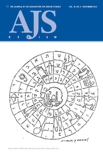
AJS Review-The Journal of the Association for Jewish Studies
Advancing Jewish Studies through Interdisciplinary DialogueAJS Review - The Journal of the Association for Jewish Studies is a leading academic journal published by the University of Pennsylvania Press, dedicated to advancing scholarship in Jewish studies. With its ISSN 0364-0094 and E-ISSN 1475-4541, the journal offers a rich compendium of research from various disciplines, including cultural studies, history, literature and literary theory, and religious studies. Recognized within the Q2 and Q3 quartiles across multiple categories in 2023, AJS Review provides an esteemed platform for academics to disseminate innovative ideas and engage with critical issues relevant to Jewish history and culture from 1976 to 2024. Although not an open-access journal, it ensures that high-quality, peer-reviewed articles are available to a global audience, enabling researchers, professionals, and students to foster deeper insights into Jewish narratives and heritage. By promoting interdisciplinary dialogue, AJS Review is integral to the academic community, offering valuable contributions to our understanding of Jewish studies and its broader implications.
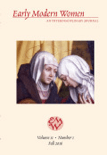
Early Modern Women-An Interdisciplinary Journal
Transforming Understanding of Gender Through Interdisciplinary ResearchEarly Modern Women: An Interdisciplinary Journal, published by the University of Chicago Press, serves as a vital platform for exploring the diverse experiences and contributions of women during the early modern period. With an ISSN of 1933-0065 and an E-ISSN of 2378-4776, this journal aims to enrich the discourse in gender studies by presenting interdisciplinary research that spans literature, history, and cultural studies. Although currently categorized in the Q4 quartile within Gender Studies and ranking in the 5th percentile, it plays an essential role in nurturing upcoming scholarship in a field marked by ongoing exploration and debate. Aimed at researchers, professionals, and students alike, the journal not only provides critical insights but also fosters dialogue about gender dynamics in historical contexts. By focusing on the convergence of scholarly efforts from 2010 to 2011 and 2015 to 2024, the journal ensures a comprehensive examination of its evolving scope, inviting contributions that will shape understanding of women's roles in early modern societies.
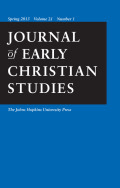
JOURNAL OF EARLY CHRISTIAN STUDIES
Connecting Religion, History, and CultureJournal of Early Christian Studies, published by Johns Hopkins University Press, is a prestigious academic journal that delves into the rich history and development of early Christianity. With an ISSN of 1067-6341 and an E-ISSN of 1086-3184, this journal has established itself as an essential platform for scholars and researchers interested in the intersections of religion, history, and culture from antiquity to the early medieval period. Ranked in the Q2 category in both History and Religious Studies as of 2023, it holds a commendable status within the academic community, reflected in its Scopus ranks. Though it does not offer open access, readers can expect rigorous peer-reviewed articles that contribute to ongoing dialogues in the field and leverage interdisciplinary approaches to the study of early Christian texts and practices. With a commitment to advancing knowledge from 2002 through 2024, the journal provides vital insights that appeal to researchers, professionals, and students alike, fostering a deeper understanding of early Christian narratives and their impact on contemporary thought.
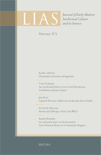
LIAS-Journal of Early Modern Intellectual Culture and its Sources
Cultivating Insights into Early Modern IntellectualismLIAS - Journal of Early Modern Intellectual Culture and its Sources is a distinguished academic journal that delves into the rich tapestry of intellectual thought from the early modern period, exploring the interplay between culture, philosophy, and literature. Published by PEETERS in Belgium, this journal serves as a vital resource for scholars and students alike, offering a platform for rigorous research and innovative perspectives in the fields of History, Literature, and Philosophy. With an ISSN of 2033-4753 and an E-ISSN of 2033-5016, LIAS has earned notable rankings in the 2023 Scopus classifications, reflecting its commitment to scholarly excellence and its growing influence within these disciplines. Although it currently does not offer open access options, it is esteemed for publishing high-quality articles that illuminate the complexities of early modern intellectual culture and its enduring impact on contemporary thought. The journal's well-curated content holds significance for researchers keen on exploring interdisciplinary approaches and contributes meaningfully to ongoing educational discourse.

OSTEUROPA
Advancing Scholarship on Eastern European AffairsOSTEUROPA is a distinguished academic journal dedicated to the examination and analysis of social, cultural, and political developments in Eastern Europe. Published by BWV-BERLINER WISSENSCHAFTS-VERLAG GMBH, this journal has been a critical voice in the field since its inception in the mid-20th century, notably converging from various years to establish a comprehensive discourse on the dynamics shaping the region. With an ISSN of 0030-6428 and an E-ISSN of 2509-3444, OSTEUROPA taps into the expansive fields of sociology and political science, holding a reputable Q3 category ranking in these disciplines for 2023. While not currently an open access publication, it remains a vital platform for researchers, professionals, and students alike who seek to deepen their understanding of Eastern European affairs. The journal also ranks in the 17th percentile within the Scopus listings, underscoring its role as a significant, albeit niche, contributor to social studies and political science scholarship. Addressed from its base in vibrant Berlin, OSTEUROPA continues to foster intellectual dialogue and provide valuable insights into the complexities of Eastern European societies.
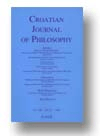
Croatian Journal of Philosophy
Engaging Minds, Expanding Philosophical HorizonsCroatian Journal of Philosophy is a distinguished academic platform dedicated to the advancement of philosophical discourse, published by KRUZAK D O O. With an ISSN of 1333-1108 and an E-ISSN of 1847-6139, this journal has been a key player in the field since its inception in 2008, continuing to progress through its converged years until 2024. Recognized for its scholarly contributions, it holds a prestigious placement in Q3 within the philosophy category for 2023 and ranks #571 out of 806 in Scopus, reflecting its engagement with a broad spectrum of scholarly discussions and ideas. Though it operates without an Open Access model, the journal remains a vital resource for researchers, professionals, and students who are keen to explore contemporary and traditional philosophical issues from diverse perspectives. The journal's commitment to expanding the boundaries of philosophical inquiry emphasizes the significance of interdisciplinary dialogue, making it a reputable choice for those seeking to deepen their understanding of philosophical thought.
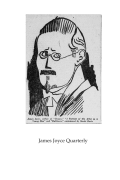
JAMES JOYCE QUARTERLY
Advancing Scholarship on Joyce's Literary LegacyJAMES JOYCE QUARTERLY is a distinguished journal devoted to the scholarship and exploration of the works of James Joyce, a pivotal figure in modern literature. Published by University of Tulsa, this journal plays a vital role in fostering a deeper understanding of Joyce's contributions to literary theory and narrative innovation. The journal does not currently offer Open Access options, yet it continually engages with both established scholars and emerging voices in the field. With its ISSN 0021-4183 and E-ISSN 1938-6036, the JAMES JOYCE QUARTERLY has established itself within the literature and literary theory landscape, earning a 2023 Scopus rank of #842 out of 1,106 in its category, which places it in the 23rd percentile. Engaging readers from its inception in 1989 and through various publication cycles, this quarterly invites contributions that challenge, critique, and expand upon Joycean studies. As a Q4 journal, it serves as an accessible platform for emerging research in literary scholarship, making it an invaluable resource for researchers, professionals, and students seeking to delve deeper into the nuances of Joyce's literary prowess.

Umeni-Art
Exploring the Intersection of Art and ScholarshipUmeni-Art is a prominent journal in the field of visual arts and performing arts, published by the Institute of Art History, Academy of Sciences, Czech Republic. With its ISSN 0049-5123 and E-ISSN 1804-6509, the journal has established itself as a critical platform for scholarly discourse and artistic expression since its inception in 2002. Although currently classified in Q4 within the Arts and Humanities category, it aims to elevate the understanding and appreciation of the arts through rigorous research and innovative perspectives. The journal's Scopus ranking places it at Rank #573/667, reflecting its growing contribution to the field and expanding reach within the artistic community. With a focus on fostering collaboration among researchers, practitioners, and students, Umeni-Art seeks to enrich the academic landscape with significant findings and discussions that inspire future research and creative endeavors. While it does not offer open access, the journal remains a valuable resource for those vested in exploring the dynamic interplay between art, culture, and society in the contemporary context.

Journal of Early Modern Studies
Connecting Cultures Through Scholarly ResearchJournal of Early Modern Studies is a premier open-access academic journal published by FIRENZE UNIV PRESS, dedicated to advancing scholarly research in various interrelated fields, including Cultural Studies, History, Literature and Literary Theory, Religious Studies, Linguistics and Language, Sociology and Political Science, and the Visual Arts and Performing Arts. Established in 2012, this journal plays a vital role in disseminating critical insights into the complexities of the early modern period, positioning itself among the fast-evolving dialogue within the humanities and social sciences. Notably, it has achieved respectable rankings, with a Q2 quartile in History and Literature for 2023, highlighting its contributions to academia. The Journal's dynamic scope continues to attract an engaged readership from across the globe, aiming to foster interdisciplinary dialogue through high-quality, peer-reviewed research. With a commitment to accessibility, it provides free online access to all published articles, ensuring that knowledge is readily available to researchers, professionals, and students alike. The journal’s ongoing efforts in scholarly excellence reflect its importance in shaping the future of early modern studies.
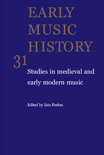
EARLY MUSIC HISTORY
Illuminating the Soundscapes of HistoryEARLY MUSIC HISTORY is an esteemed academic journal published by Cambridge University Press, specializing in the rich and diverse field of early music, providing a vital platform for research and discourse since its inception. With an ISSN of 0261-1279 and an E-ISSN of 1474-0559, the journal operates from its headquarters in Cambridge, United Kingdom. Known for its scholarly rigor, EARLY MUSIC HISTORY is ranked within the Q2 category in Music, illustrating its significant contribution to the field. The journal covers a broad time frame, examining musical developments from the medieval to the early modern period, and features articles that seek to illuminate historical contexts and contemporary implications of early music practices. Despite lacking the Open Access option, it remains a valued resource for researchers and professionals seeking to advance their understanding of this dynamic area of study. The journal not only fosters a deeper appreciation of early music history but also positions itself as a pivotal contributor to ongoing academic dialogue, making it essential reading for scholars in the arts and humanities.